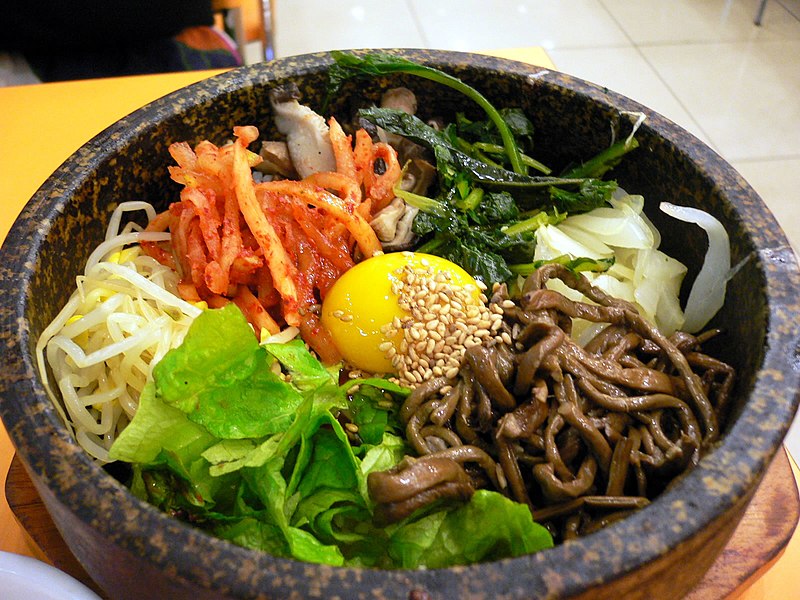 Korean food is based on pasta, rice, meat, vegetables and tofu (known in Korea as "dubu"). Is to provide meals usually with several side dishes ("banchan"), as well as steamed rice, soup and kimchi (fermented vegetables, in most cases, but in some cases, the option of cabbage or radish). Used widely Spices & Seasonings, including doenjang (fermented soybean paste), garlic, ginger, gochujang (red chili paste), salt and soy sauce.
Korean food is based on pasta, rice, meat, vegetables and tofu (known in Korea as "dubu"). Is to provide meals usually with several side dishes ("banchan"), as well as steamed rice, soup and kimchi (fermented vegetables, in most cases, but in some cases, the option of cabbage or radish). Used widely Spices & Seasonings, including doenjang (fermented soybean paste), garlic, ginger, gochujang (red chili paste), salt and soy sauce.Some popular Korean dishes include the following:
Feet - Gamjatang - hot soup and spine using pork, potatoes and other vegetables, and green onions, chilies and sesame seeds.
Soccer - Kimchi jjigae - and kimchi soup with pork and tofu.
- Kongnamul - Guk - and soup made from the buds of soybeans.
Feet - Jeongol - soup with seafood and vegetables.
- Maeuntang - Hot and spicy fish soup.
- Bulgogi - translated literally from Korean, Bulgogi means "fire meat." The dish consists of beef, shredded or thinly sliced, then cooked on a grill. May be substitued other meat to create variations: chicken ("Dak bulgogi"), and pork ("dweji bulgogi"), or squid ("ojingeo bulgogi").
 - Chalabi (or canine) - pork or cooked on coal ribs.
- Chalabi (or canine) - pork or cooked on coal ribs.- Dakgalbi - like Chalabi, but using chicken seasoned.
- Jokbal - pig feet in cooked in soy sauce and spices, deboned, and served with shrimp sauce.
- Samgyeopsal belly of pork - (similar to ham), flavored and seasoned with garlic cooked sesame oil and salt, on the grill. Put steaks in lettuce or other leafy green vegetables, along with cooked rice and ssamjang (spicy paste). Decreased green peppers, slices of raw garlic in ssamjang and spring onion power, and the associated joint.
- Makchang - Grilled pig intestines, somewhat similar to chitterlings.
- Hoe - thin slices of raw fish, sashimi-style Japanese cuisine. The fish is usually down in the sauce, either chogochujang a sauce made from gochujang (red chili paste), or wasabi sauce, then wrapped in green leaves, and served on a bed of dangmyeon (cellophane noodles).
 - Beef Yukhoe crude - especially with raw egg yolks and seasoned with black pepper and garlic, onions gochujang (red chili paste), green, Nashi pear, sesame seeds, sesame oil, soy sauce and sugar.
- Beef Yukhoe crude - especially with raw egg yolks and seasoned with black pepper and garlic, onions gochujang (red chili paste), green, Nashi pear, sesame seeds, sesame oil, soy sauce and sugar.- Sannakji - and small octopus, cut in pieces, seasoned and served slightly. Octopus pieces are usually still moving on the plate when the dish is offered!
- Japchae - boiled potatoes and spinach with pasta, meat, onions and carrots.
- Kalguksu - flat noodles boiled, usually in the anchovies, which contains the pumpkin soup (squash).
- Kongnamul - bap - soya bean sprouts served over rice.
 - Ramyeon - Korean version of Japanese ramen noodles. Hot and cooked with meat and vegetables.
- Ramyeon - Korean version of Japanese ramen noodles. Hot and cooked with meat and vegetables.- Gujeolpan - translated literally from Korean, Guljoelpan means "dish of nine dishes." This meal is very complicated, traditionally eaten by the nobility Korean, and he was a member of the special panel is divided into eight sections of the octagon, each containing meat and vegetables from a different type and color, and the Department of the Centre for the ninth that contains the pancakes small.
- Tteok - and candy made from sweet glutinous rice flour - there are hundreds of different forms.

Tidak ada komentar:
Posting Komentar